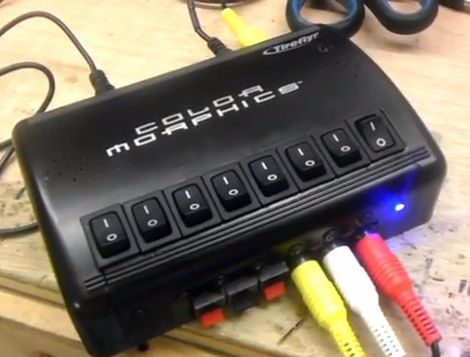
It seems like [Chris Downing] is always up to something new. If he’s not keeping busy by creating slick portable iterations of previous-gen gaming consoles, he is dreaming up ways to make his modding life a bit easier.
Recently while working on a Nintendo controller designed to control three different consoles, [Downing] found his desk buried in a pile of power supply and A/V cabling. Annoyed with his growing rat’s nest, he decided to build a universal power supply that would allow him to quickly switch between consoles with little effort.
He dug up an old PC power supply, and fed it into a LED control box built for cars. [Downing] then mounted an array of nine rocker switches on the box, adding A/V inputs and outputs along the way. A set of voltage regulators hidden inside allow [Downing] to dial in whatever custom voltages he might need at the moment.
The test box should come in pretty handy as [Downing] pursues even more modding projects in the months to come. In the meantime, be sure to check out the video below where he covers the finer points of the device’s design.
[youtube=http://www.youtube.com/watch?v=SO6KLmPpXlk&feature=player_embedded&w=470]














Thanks to Mike for the write up! Should say that the variable voltages are not in quite yet, but will be as soon as they get here. Adding two voltmeters and an LED tester. Should be pretty nice once done.
One thing I would add that is extremely important on bench supplies is current limiting. You can go all out with opamps and such but if you really want to do it cheap , resistors will get the job done. It is so much nicer when you connect up a new piece of hardware and it doesn’t work, you fix the problem then power up the hardware, VS, connect the hardware, power up and your new hardware goes up in a puff of smoke because you had no current limiting.
What would you recommend? It is granted that I’m not going to need the amount of Amps that come out of a PSU for anything in the foreseeable future. It’s all quite stable as it is right now, but even from a safety point, I wouldn’t mind stepping the amps down to say 6 Max.
The easiest way to limit current is with resistors. You will need to use power resistors of the 5-10W range. To limit something like 9V to 1A you use ohms law, R=V/I, current is 1A, Voltage is 9V, R is then 9 ohms. To determine the size of resistor needed for the total 1A load , watts = V x I , 9 x 1 = 9 watts, so 10 watt resistor.
9ohm resistors are rare so use the closest one, 10 ohms.
Placing a 10 watt, 10 ohm resistor in series with the powered device will prevent the device from drawing anything over 1A.
total cost to limit the current , about 50 cents !
For 12V at 6 amps, you need to be able to dissipate 12V x 6A = 72 watts .
resistor ohms needed is 12V / 6A = 2 ohms.
Cost about $6 and will need to be attached to a heat sink of some sort if you intend to really use all 6A.
Well, I’ll probably not need anything more that 4 to be all honest. But the other good thing that I’ve got going here is that the PSU has a circuit breaker in place so any over draw or short the unit shuts off. But thank you for the info, that’s good to know and from a safety standpoint, that’s probably what I’ll do, even though 6amps is still enough to toast ya.
It works alright to start at your minimum volts and slowly turn it up while watching the current gauge. If the current suddenly starts to climb or is too high to begin with, you know something’s wrong.
I see. Well 6 of the 8 voltages are per-determined anyway. By that I mean they are direct voltage lines from the PC Power Supply Unit. They seem to be pretty stable but have way more amps than I need. The other 2 (one on each channel) will be variable, reduced down from 12V and the volt meters that I’m putting in place will tell me right where they are at +/- .02v.
I do think it’s pretty secure though so when I finish off the final build then I’ll see what you guys think. This concept is pretty new to me, so I’m sure there are a couple things I can do better.
Reblogged this on Downing's Basement and commented:
Thank You HAD! I’m always very excited when a project get’s picked up on your site. It helps me out considerably!